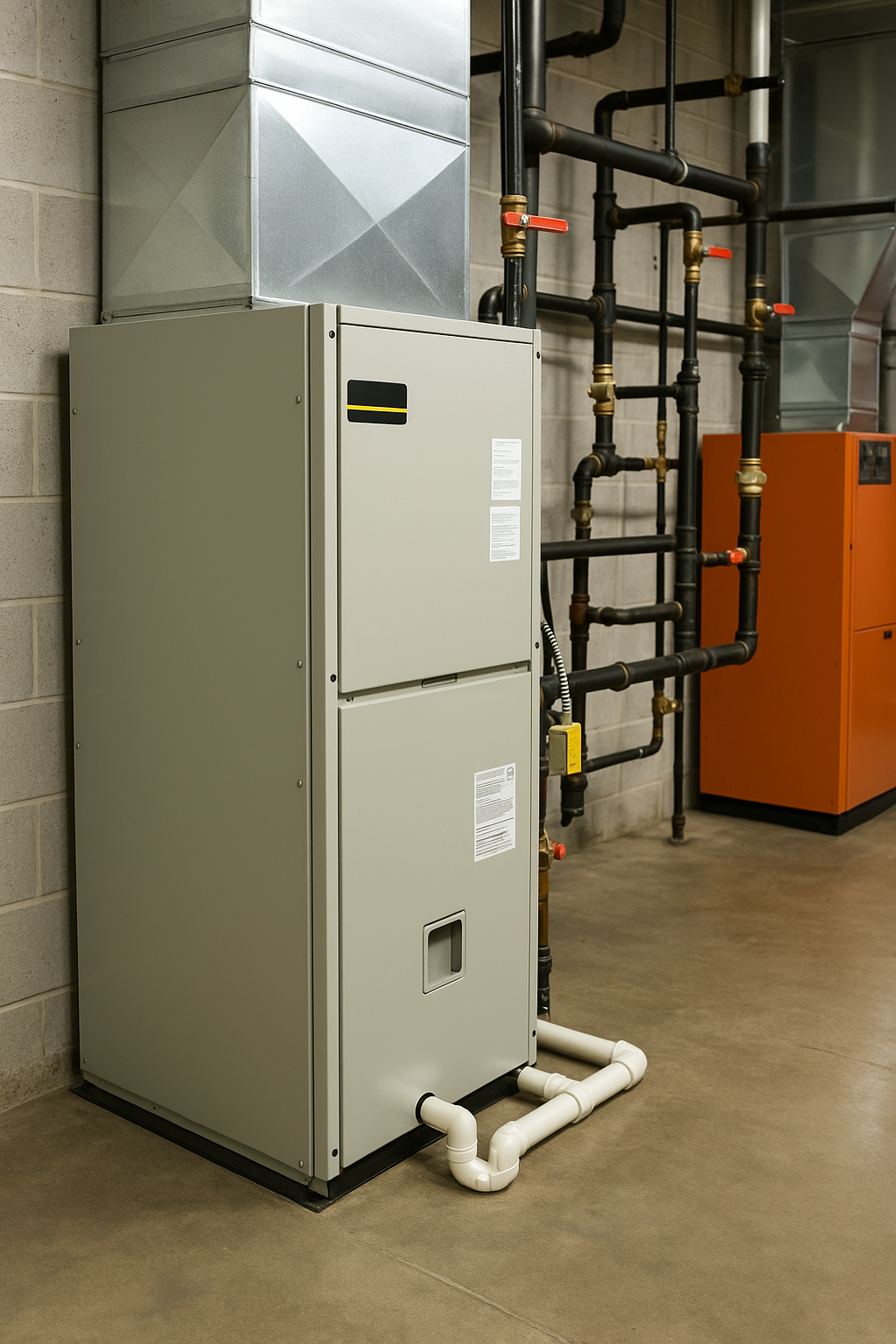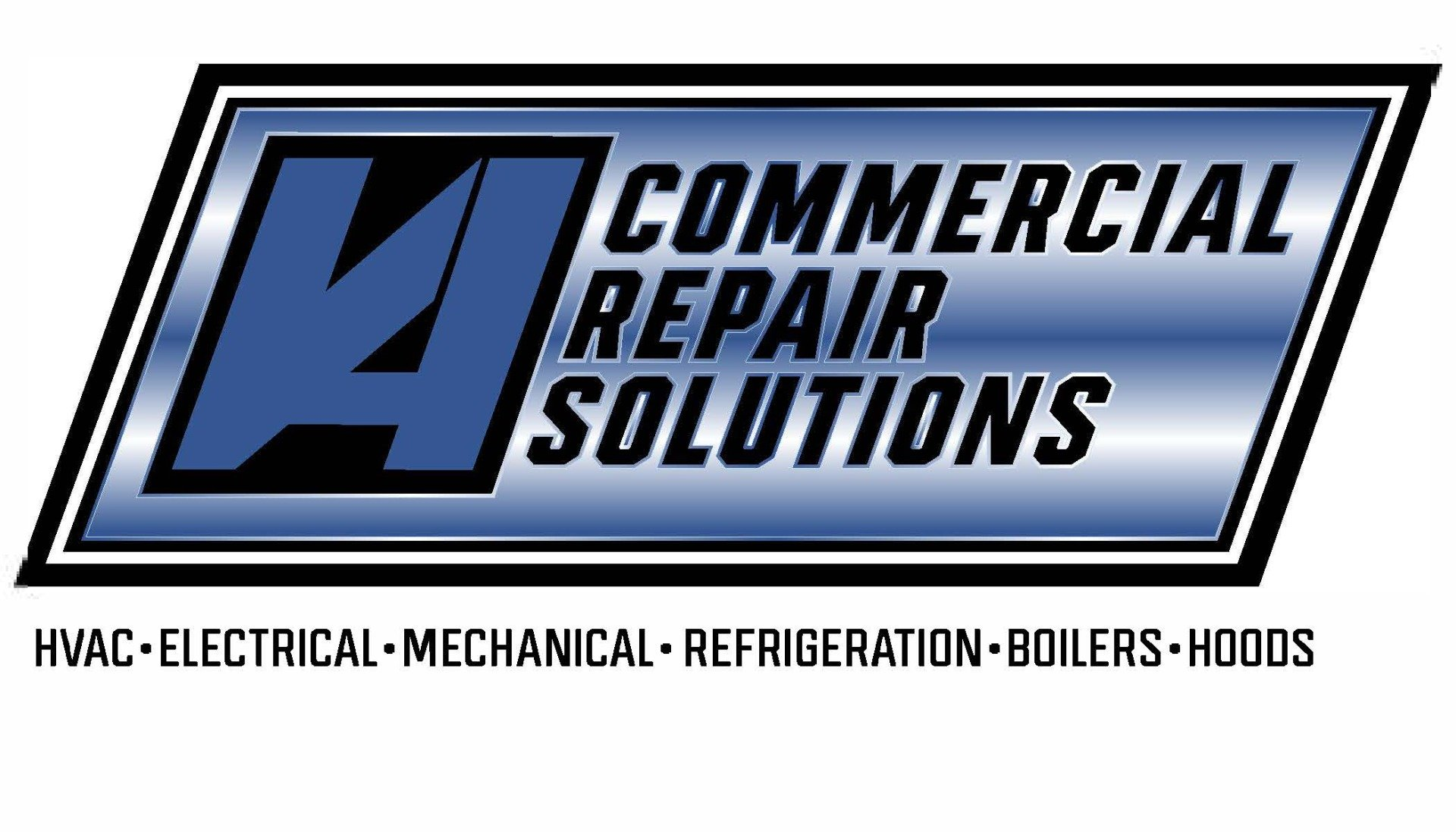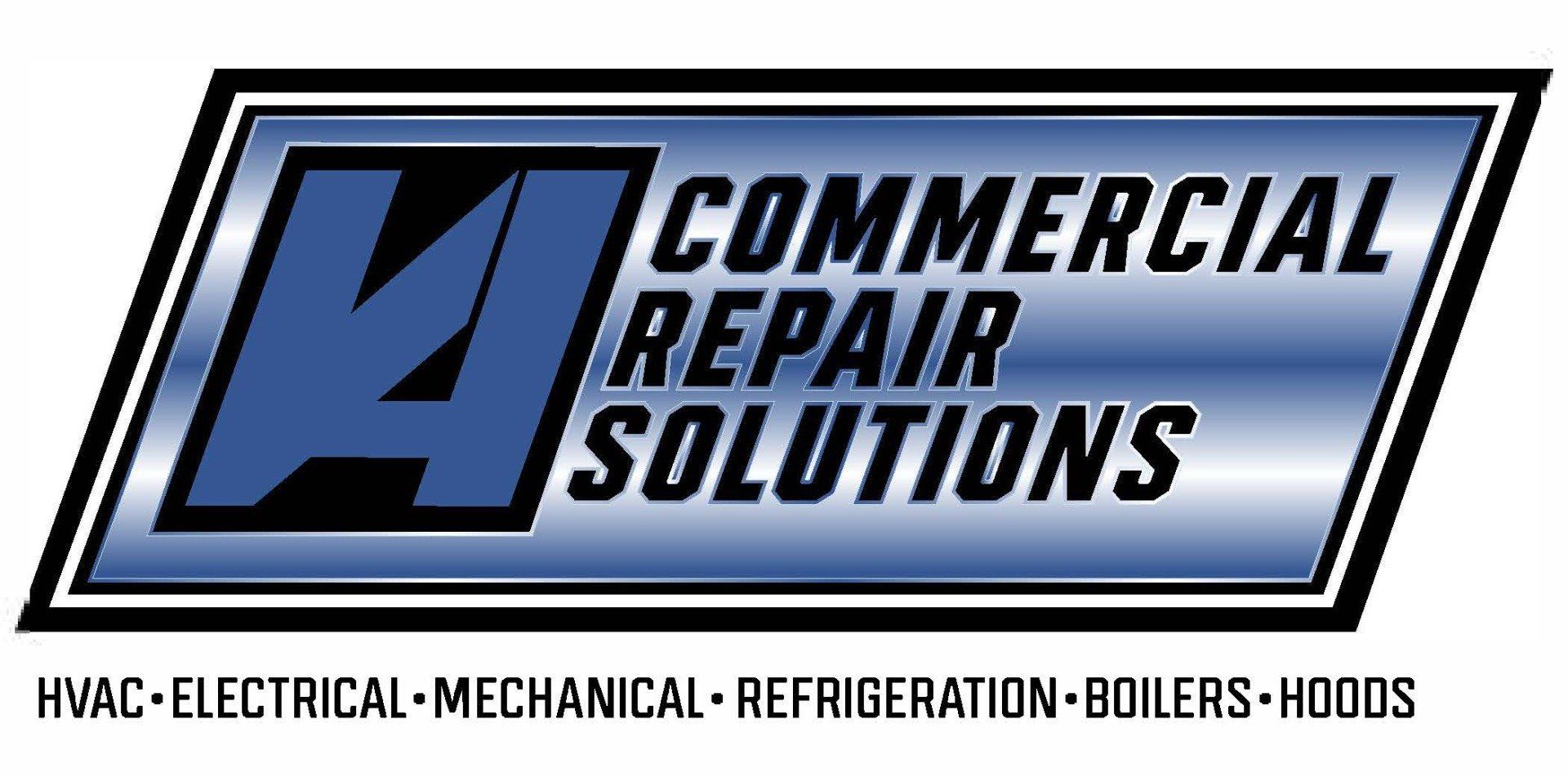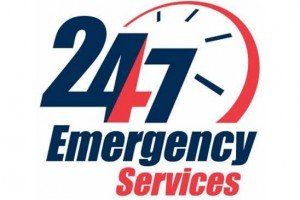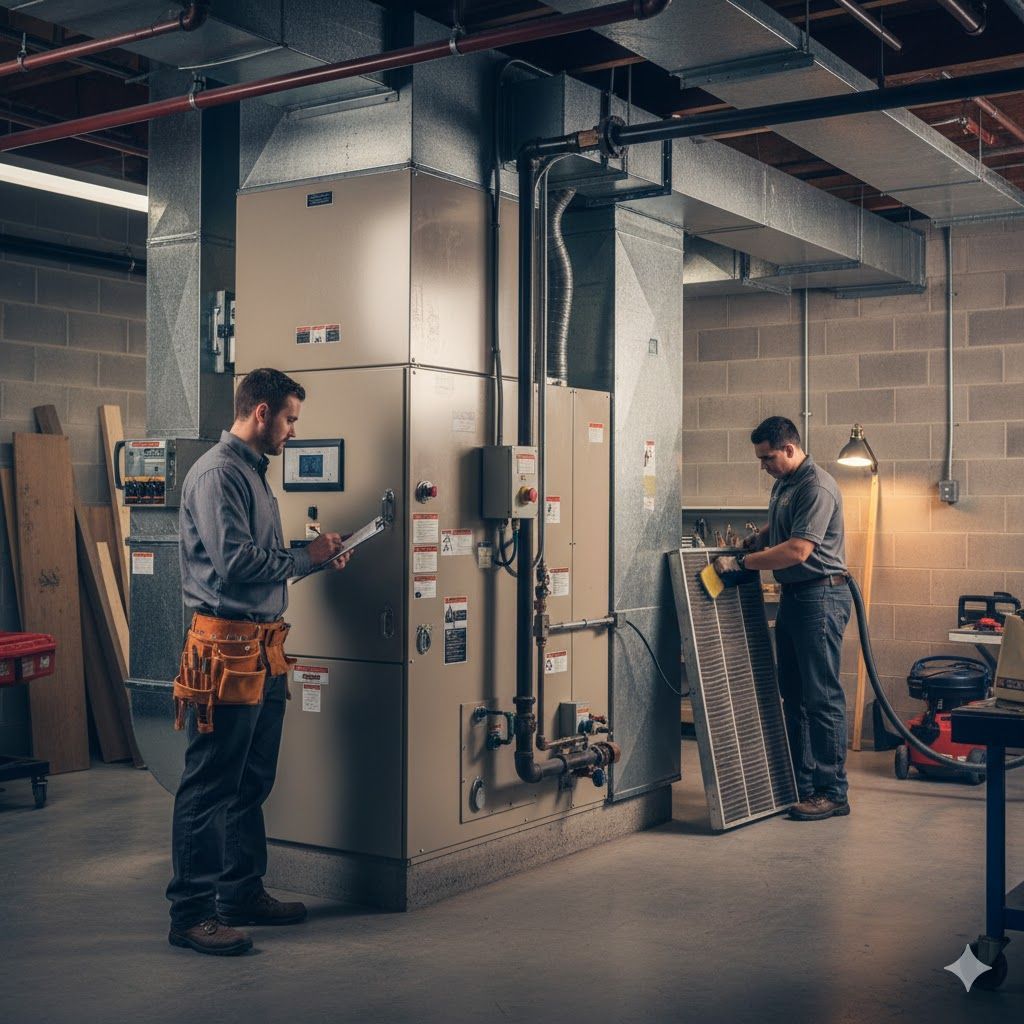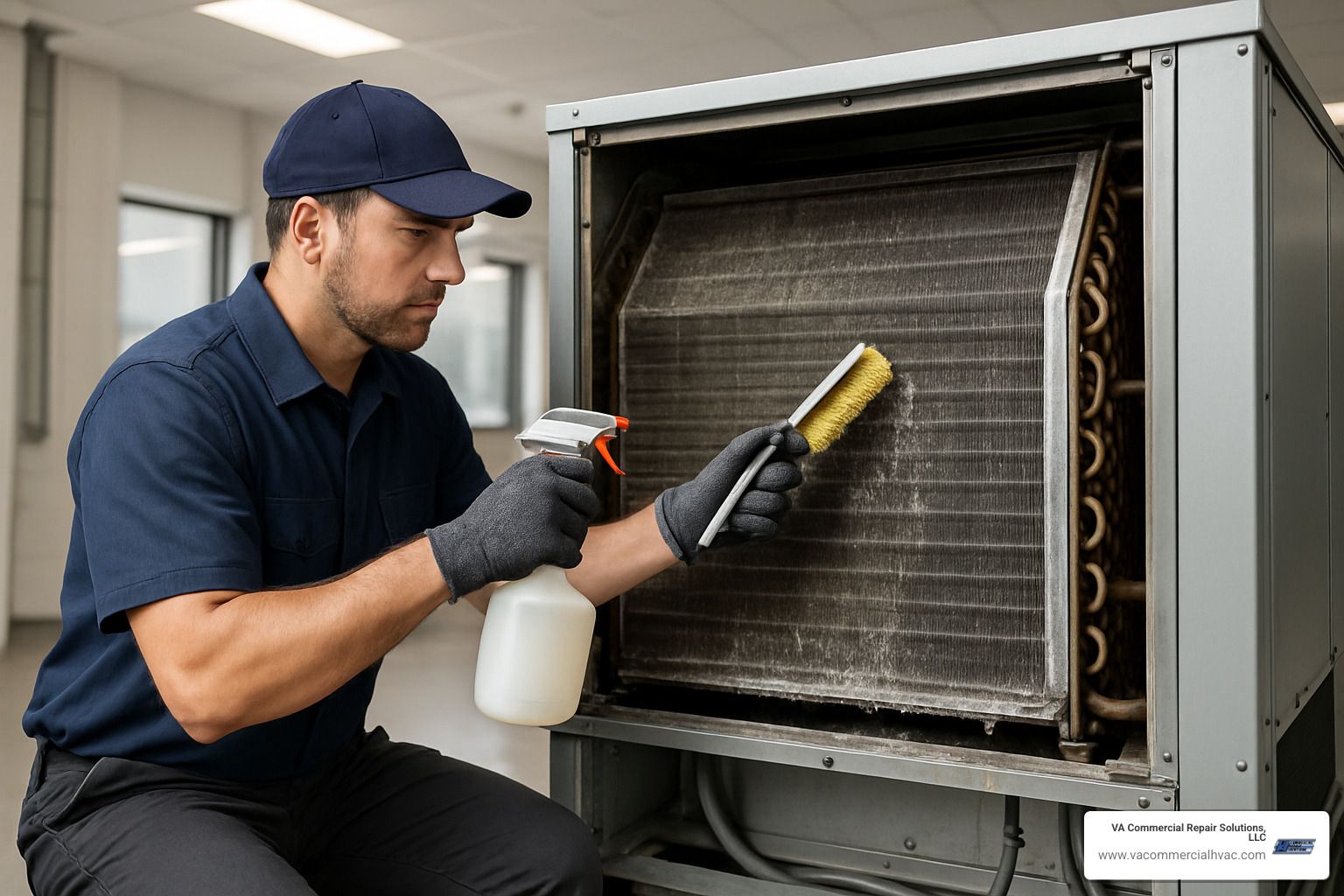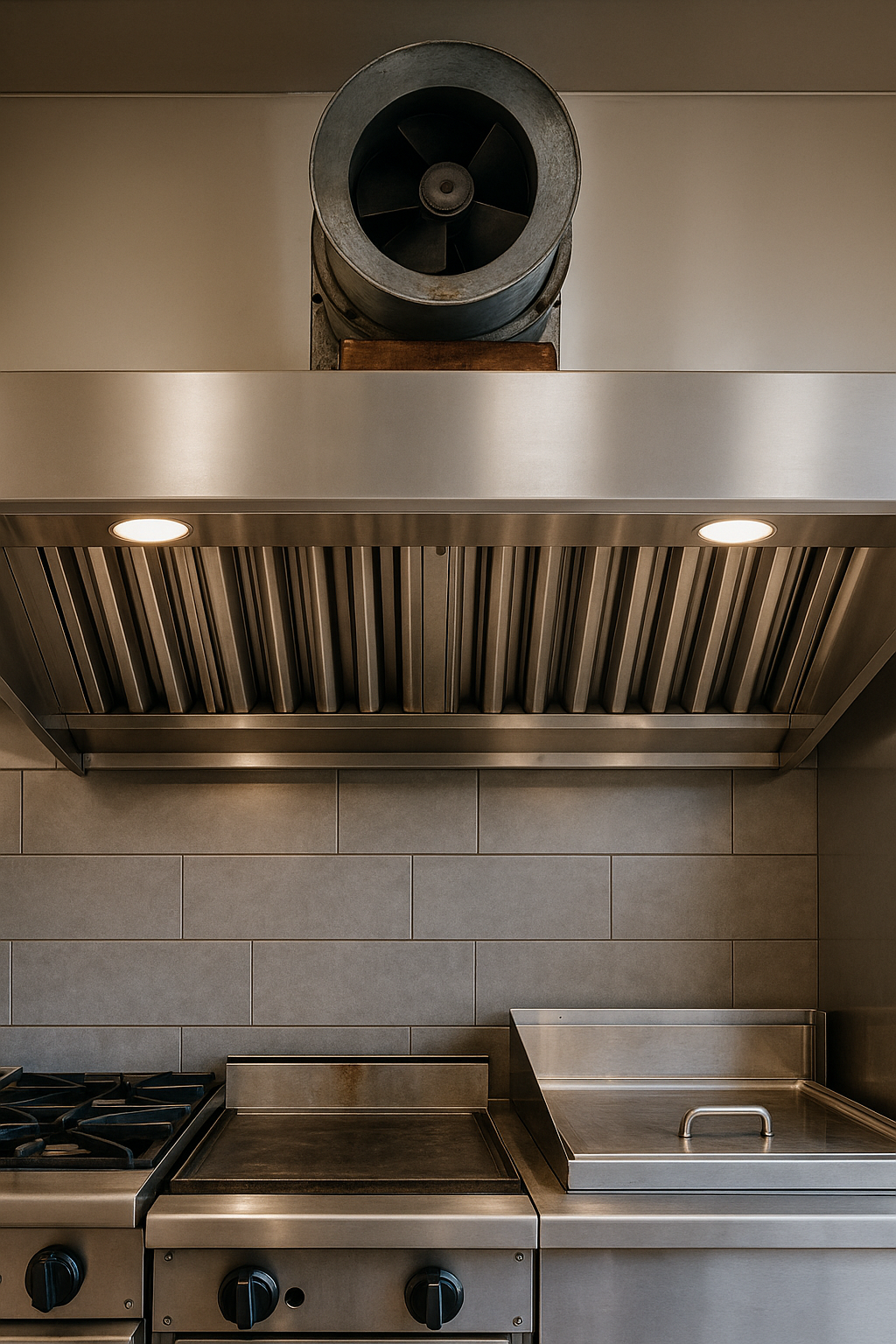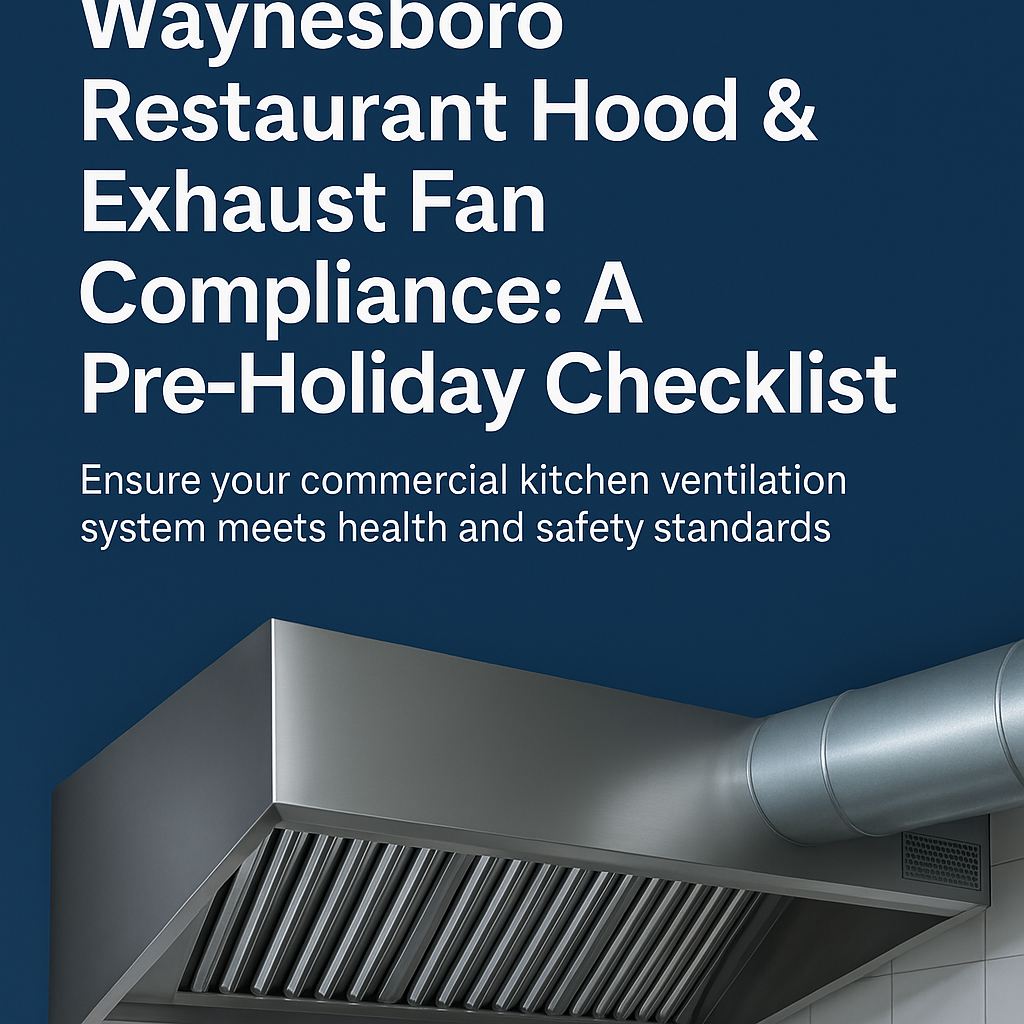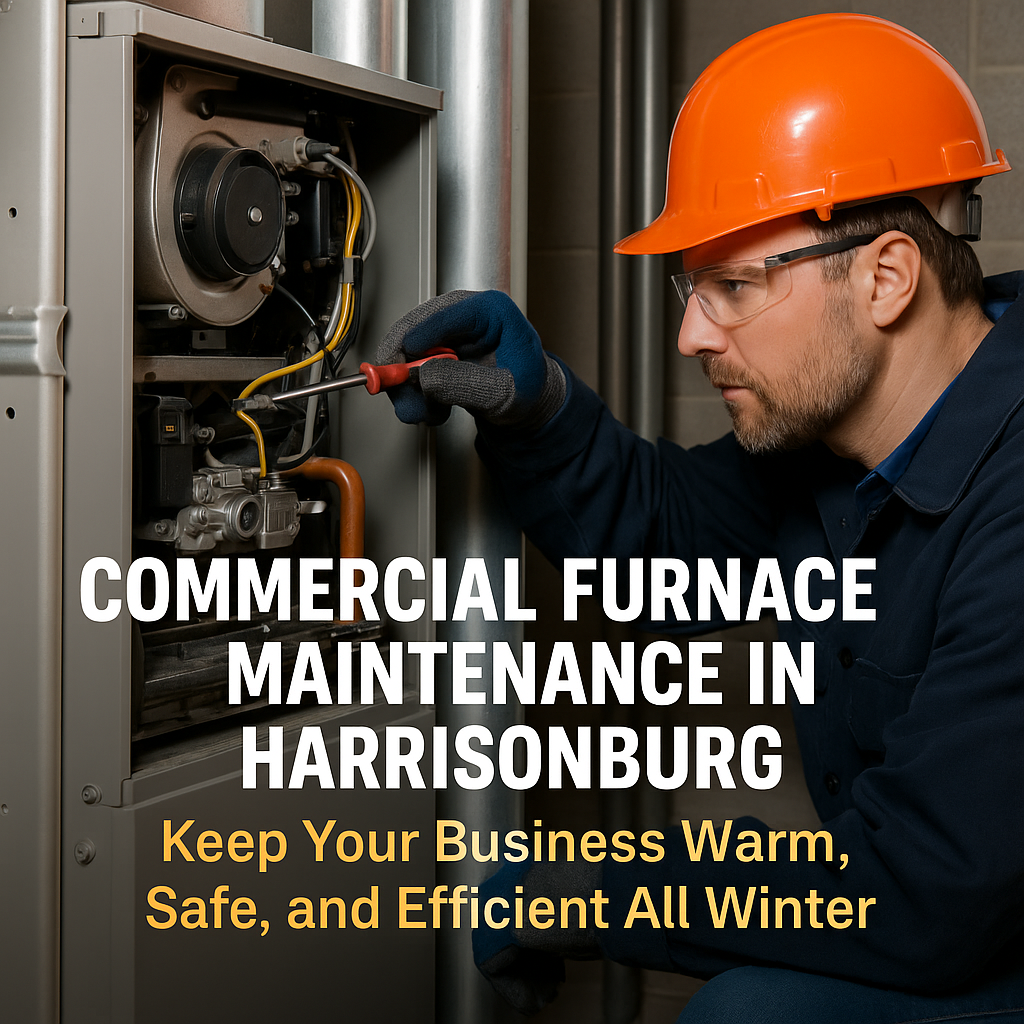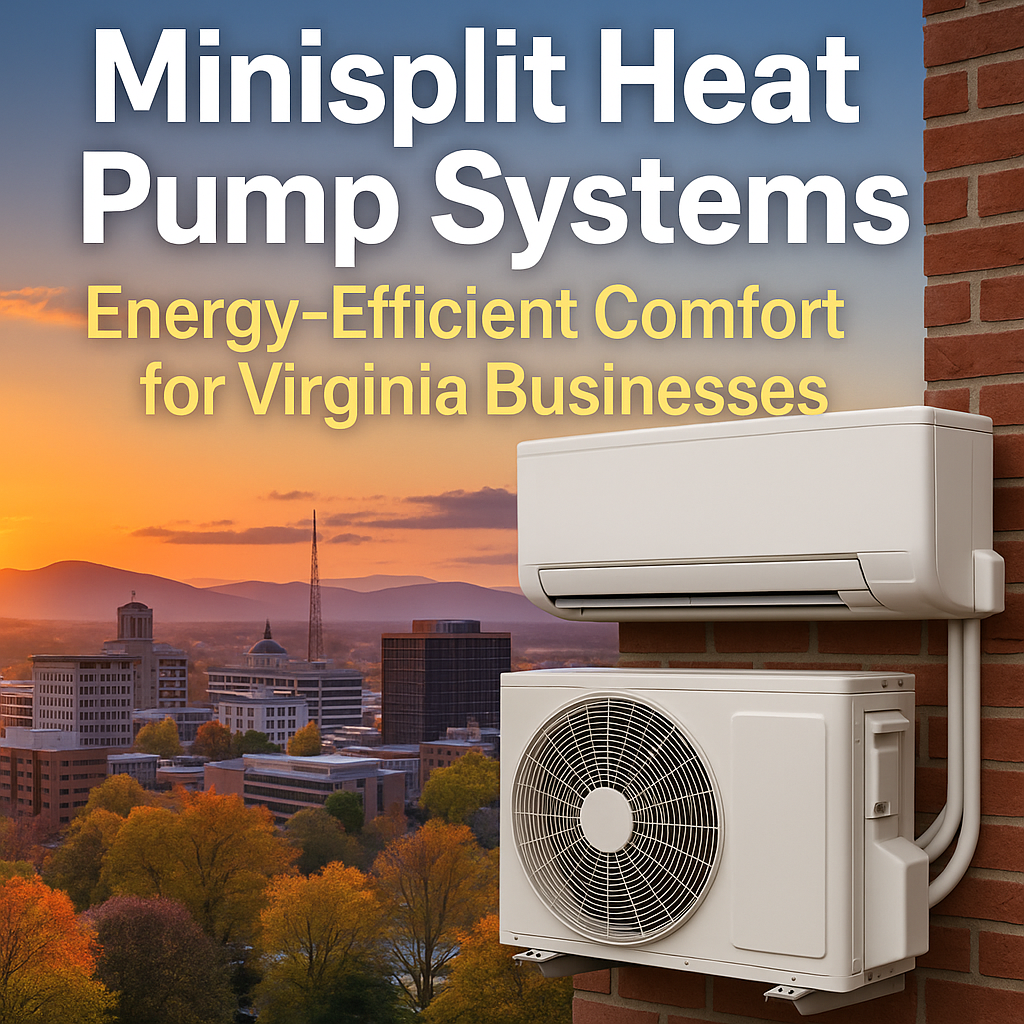Charlottesville VA Commercial AC Installation: Modern Cooling for Historic Architecture
Expert HVAC Solutions for Downtown Mall, University District, and Historic Commercial Buildings - Preserving Architectural Heritage While Ensuring Modern Comfort
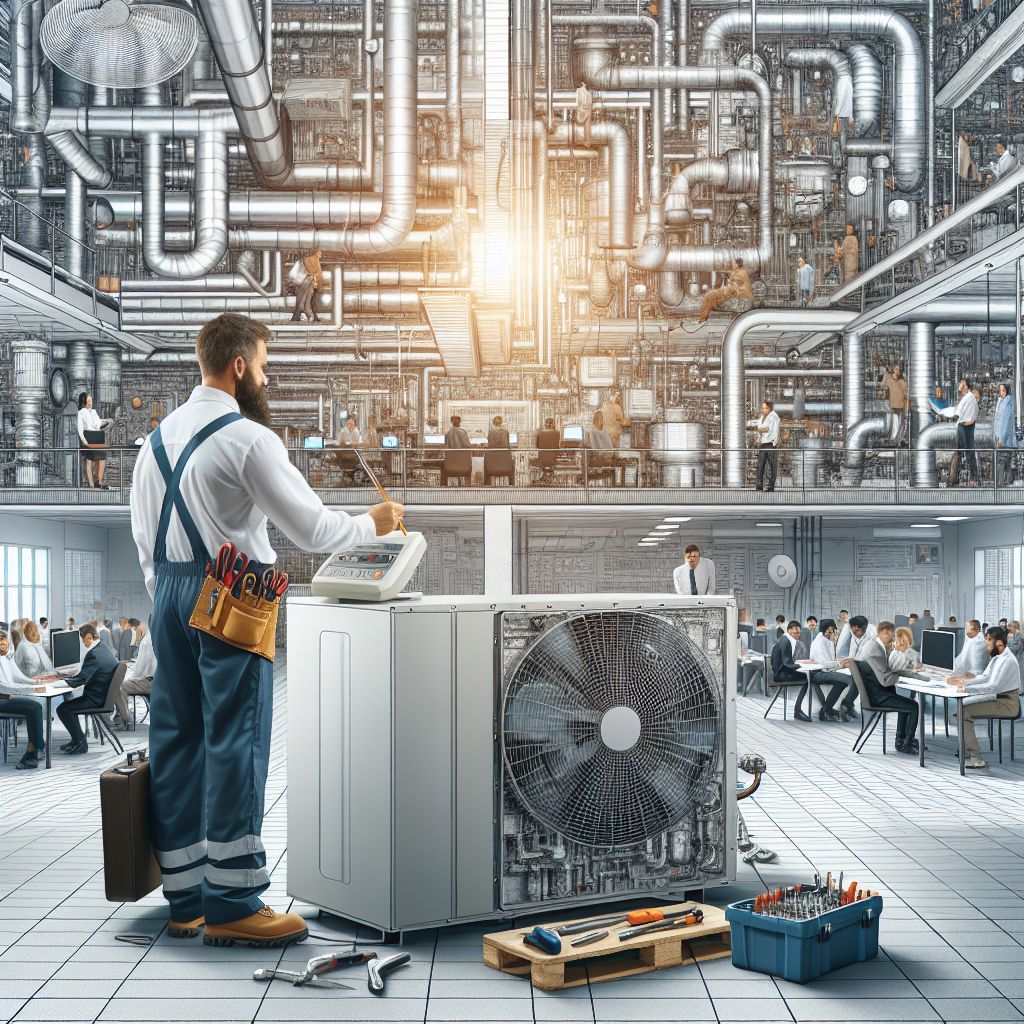
Key Takeaways
- Historic commercial buildings in Charlottesville require specialized AC solutions that balance modern comfort with architectural preservation requirements
- The Board of Architectural Review must approve most HVAC modifications in Charlottesville's historic districts, making early consultation crucial
- Variable Refrigerant Flow (VRF) and ductless mini-split systems offer superior options for historic commercial spaces due to minimal structural impact
- VA Commercial Repair Solutions brings dual expertise in both modern HVAC technology and historic preservation requirements for Charlottesville businesses
- Proper placement strategies for equipment can maintain historic aesthetics while delivering efficient cooling performance
Installing commercial air conditioning in Charlottesville's historic buildings presents unique challenges requiring specialized expertise. When modern comfort meets centuries-old architecture, ordinary HVAC solutions simply won't do. VA Commercial Repair Solutions understands the delicate balance between preserving architectural heritage and creating comfortable environments for today's businesses across Rockingham, Albemarle, and Augusta counties.
Virginia's historic commercial districts feature irreplaceable architectural elements that demand preservation-conscious climate control approaches. Unlike standard commercial installations, these projects require navigation through preservation guidelines, creative equipment placement, and technologies specifically designed for historic structures. The right commercial AC installation not only enhances comfort but contributes to the building's longevity and the continued vitality of Charlottesville's historic commercial districts.
Cooling Challenges Unique to Charlottesville's Historic Buildings
Charlottesville's historic commercial buildings present distinctive climate control challenges due to their original construction methods. These structures typically feature thick masonry walls, high ceilings, irregular layouts, and limited mechanical spaces—all design elements created long before air conditioning existed. Their thermal characteristics differ dramatically from modern buildings, requiring specialized approaches to effective cooling.
Why Traditional AC Systems Often Fail in Historic Structures
Conventional commercial HVAC systems, designed for modern construction with drop ceilings and utility chases, frequently prove incompatible with historic architecture. Standard ductwork requirements often demand alterations that compromise historical integrity or simply won't physically fit within existing spaces. Central systems typically require substantial mechanical rooms absent in historic layouts. Additionally, the vibration from traditional equipment can potentially damage fragile historic materials, creating preservation risks beyond just aesthetic concerns.
The Delicate Balance: Modern Comfort vs. Architectural Preservation
Successfully cooling historic commercial spaces requires striking a careful balance between contemporary comfort expectations and preservation principles. Today's businesses demand consistent temperature control, energy efficiency, and zone-specific management—yet these needs must be met without compromising a building's historical character. The solution lies in finding the intersection between preservation standards and modern technology, often through systems specifically designed for historic retrofits.
This balancing act becomes particularly crucial in Charlottesville's downtown commercial district, where businesses must attract customers while operating within structures that predate modern cooling concepts. Each modification must consider both immediate comfort requirements and long-term preservation implications, ensuring the building maintains its historic integrity for future generations.
Working with professionals who understand both advanced HVAC technology and historic preservation principles becomes essential. The right expertise ensures a system that not only performs efficiently but respects the building's historical significance and meets all applicable preservation guidelines.
Common Temperature Control Issues in Virginia's Older Commercial Spaces
- Uneven temperature distribution due to irregular floor plans and varying ceiling heights
- Solar heat gain through historic single-pane windows lacking modern energy efficiency
- Inadequate insulation in walls and ceilings creating significant thermal losses
- Air stratification in high-ceilinged spaces causing uncomfortable temperature variations
- Limited options for equipment placement that won't impact historic features
- Moisture management challenges that can affect both comfort and historic materials
Virginia's climate presents particular challenges for historic commercial buildings, with hot, humid summers that can create uncomfortable conditions and potentially damage historic materials through excessive moisture. These issues compound when buildings house heat-generating commercial activities like restaurants or technology-intensive businesses. Without proper system design, these spaces can become uncomfortable for employees and customers while potentially accelerating deterioration of historic features.
Critical Preservation Guidelines for Commercial AC Projects
Commercial AC installations in Charlottesville's historic districts must navigate multiple layers of preservation requirements. Understanding these guidelines early in the planning process helps prevent costly redesigns and ensures project approval. Successful installations begin with a comprehensive understanding of both the letter and spirit of preservation regulations at local, state, and federal levels.
Charlottesville's Historic District Requirements
Charlottesville's Board of Architectural Review (BAR) maintains strict oversight of modifications to buildings within designated historic districts. Any exterior alterations—including AC equipment placement—typically require BAR approval through a Certificate of Appropriateness. The review process evaluates visual impact, placement strategy, and screening methods to ensure equipment remains minimally visible from public rights-of-way. Early consultation with the BAR during planning stages often prevents issues later in the project timeline, allowing businesses to address concerns proactively rather than reactively.
Virginia Department of Historic Resources Standards
Beyond local requirements, the Virginia Department of Historic Resources (DHR) establishes standards for historic buildings, particularly those listed on the Virginia Landmarks Register. These standards generally align with federal preservation principles but may include Virginia-specific considerations for climate, regional building techniques, and historical context. For commercial properties seeking state rehabilitation tax credits, DHR review becomes mandatory, with specific attention to how HVAC systems interact with character-defining features.
The DHR emphasizes the principle of reversibility—installations should be designed to allow future removal without permanent damage to historic fabric. This encourages systems that work with existing building features rather than requiring extensive modifications that can't be undone. Meeting these standards requires thoughtful planning and innovative approaches to equipment integration.
Federal Tax Incentives for Preservation-Friendly HVAC
Commercial property owners in Charlottesville can access significant federal tax incentives for preservation-compliant HVAC upgrades. The Federal Historic Preservation Tax Incentives program offers a 20% tax credit for certified rehabilitation of income-producing historic properties. To qualify, HVAC installations must meet the Secretary of the Interior's Standards for Rehabilitation, which emphasize preserving character-defining features while accommodating necessary mechanical systems.
These tax credits can substantially offset installation costs, making preservation-friendly systems more financially viable. However, they require careful documentation and adherence to specific standards throughout the project. Working with contractors experienced in both historic preservation and tax credit requirements ensures proper documentation and compliance from planning through completion.
Required Permits and Review Processes
Commercial AC installations in historic Charlottesville buildings typically require multiple permits and reviews beyond standard mechanical permits. These may include Certificate of Appropriateness from the BAR, building permits addressing structural modifications, electrical permits for power requirements, and potentially special use permits depending on equipment locations. The review timeline can significantly impact project scheduling, with some approvals requiring public hearings scheduled weeks or months in advance.
Successful projects begin with a comprehensive permitting strategy that accounts for these parallel approval processes. Experienced contractors coordinate these requirements to prevent delays that could leave businesses without proper cooling during Virginia's hot summer months.
5 Best AC Systems for Historic Commercial Buildings
Not all commercial cooling systems are suitable for historic structures. The ideal systems minimize structural impact while maximizing efficiency and zoning capabilities. Modern technologies now offer several options specifically advantageous for historic retrofits, each with particular strengths depending on building characteristics and business needs.
1. Variable Refrigerant Flow (VRF) Systems
VRF systems represent the gold standard for historic commercial installations, offering exceptional efficiency with minimal invasiveness. These systems use small-diameter refrigerant lines instead of bulky ductwork, dramatically reducing the need for structural modifications. A single outdoor unit can connect to multiple indoor air handlers, each independently controlled, allowing precise zoning for irregular historic layouts.
For Charlottesville businesses occupying multi-story historic buildings, VRF systems excel at handling the vertical distribution challenges that often complicate traditional HVAC approaches. The energy efficiency of these systems—often 30% more efficient than conventional systems—provides significant operational savings that help offset initial investment costs. Their quiet operation also prevents noise pollution that could detract from historic ambiance.
2. Ductless Mini-Split Solutions
Ductless mini-splits offer excellent flexibility for smaller historic commercial spaces or targeted cooling needs. Similar to VRF systems but typically smaller in scale, mini-splits connect indoor air handlers to outdoor condensers through small refrigerant lines requiring only minimal wall penetrations. Their compact indoor units can be mounted high on walls, recessed in ceilings, or configured as floor-standing models to accommodate various historic interiors.
For Charlottesville retail spaces, offices, or restaurants with limited square footage, mini-splits provide cost-effective zoning without major construction. They're particularly valuable for historic buildings with multiple small rooms where traditional ducting would be impractical. When properly positioned, indoor units can blend with interior design elements or be concealed behind architectural features.
3. High-Velocity Small-Duct Systems
High-velocity systems utilize flexible mini-ducts only 2-3 inches in diameter, allowing installation within existing walls, floors, and ceiling cavities without significant demolition. These systems move air at higher speeds through smaller openings, providing effective cooling with minimal visual impact. The small, round outlets can be painted to match surrounding surfaces, making them far less conspicuous than conventional registers.
This technology proves particularly valuable in Charlottesville's masonry commercial buildings where wall thicknesses provide natural chases for running small ducts. For businesses seeking a central air approach without conventional ductwork requirements, high-velocity systems offer an effective compromise between performance and preservation.
4. Chilled Beam Technology
Active chilled beam systems represent an innovative approach particularly suited to historic commercial buildings with high ceilings. This technology uses small pipes carrying chilled water to cooling units installed in ceilings, which then cool air through convection principles. The minimal air movement requirements dramatically reduce duct sizes compared to forced-air systems.
For large open commercial spaces like restored warehouses or manufacturing buildings now serving as offices or retail spaces, chilled beams provide efficient cooling without extensive ceiling modifications. Their silent operation and elimination of visible blowing air create comfortable environments without disrupting historic character. While installation costs typically exceed conventional systems, energy savings of 20-30% provide long-term operational benefits.
5. Geothermal Heat Pump Options
Geothermal systems leverage the earth's constant underground temperature to provide highly efficient heating and cooling. For historic commercial properties with available land for ground loops, geothermal offers exceptional efficiency with minimal visual impact since equipment remains largely hidden underground. These systems pair particularly well with historic buildings because the indoor components require relatively little space compared to conventional equipment. When planning commercial AC installation in Charlottesville, VA, property owners in historic districts should consider geothermal as a viable option.
While installation costs exceed most other options, geothermal systems deliver unmatched operational efficiency, often reducing energy consumption by 30-70% compared to conventional systems. For Charlottesville businesses planning long-term occupancy in historic buildings, the return on investment typically materializes within 5-10 years through dramatically reduced operating costs. Their exceptional durability—often lasting 25+ years for indoor components and 50+ years for ground loops—makes them particularly valuable for historic structures where minimizing future interventions remains a priority.
Hidden Equipment: Placement Strategies That Preserve Aesthetics
Strategic equipment placement plays a crucial role in balancing effective cooling with historic preservation. The goal is to make modern mechanical systems essentially invisible from public view while ensuring proper operation and maintenance access. Creative placement solutions often determine a project's preservation compliance while maintaining system performance.
Rooftop Installation with Proper Screening
Rooftops often provide ideal locations for outdoor condensing units, particularly on commercial buildings with flat or low-slope roofs common in Charlottesville's historic districts. Proper setbacks from roof edges prevent units from being visible from street level, while custom screening systems can conceal equipment when visibility remains a concern. Historic-appropriate screening materials like copper or patinated metal can integrate with building aesthetics while serving functional purposes.
Rooftop placement requires careful structural assessment to ensure historic framing can support equipment weight and prevent vibration transfer. Strategic positioning must also account for service access, allowing maintenance without disturbing historic features. For buildings with historic roof materials, elevated mounting systems can prevent penetrations and damage while facilitating proper drainage and roof maintenance.
Basement and Crawlspace Utilization
Many historic commercial buildings in Charlottesville feature substantial basements or crawlspaces that can house HVAC equipment without impacting visible spaces. These locations offer natural sound isolation, vibration control, and complete visual concealment. Modern condensing units designed for indoor installation can utilize basement locations when properly ventilated, eliminating exterior equipment entirely.
Effective basement installations require careful moisture management and often benefit from dedicated equipment rooms with proper waterproofing and drainage systems. Air distribution requires particular attention to prevent humidity issues that could damage historic materials. For buildings with limited basement access, modular equipment that can be transported through narrow historic doorways or windows proves essential for successful installations.
Interior Equipment Concealment Techniques
When equipment must be located within historic interiors, creative concealment approaches maintain historic character while accommodating modern systems. Strategies include custom millwork designed to match historic details, repurposed historic features like non-functional fireplaces or dumbwaiters, and dedicated mechanical closets created in less historically significant areas. For retail and restaurant spaces, equipment integration into display fixtures or service areas can maintain period aesthetics while providing necessary cooling.
Indoor air handlers often find homes within existing closets, storage areas, or purpose-built enclosures finished to match surrounding historic details. In commercial spaces with high ceilings, suspended units can be concealed above historically appropriate decorative elements. These approaches require close collaboration between HVAC designers, preservation specialists, and interior designers to ensure both functional performance and aesthetic compatibility.
Advanced Zoning for Irregular Historic Layouts
Historic commercial buildings typically feature irregular layouts that create cooling challenges unfamiliar to modern construction. Different ceiling heights, varying window exposures, and non-standard room configurations create microclimates that demand sophisticated zoning approaches. Effective commercial comfort in these spaces requires systems capable of delivering precise temperature control to distinct areas with different cooling loads and occupancy patterns.
Creating Effective Temperature Zones in Open Floor Plans
Many adapted historic commercial spaces feature open floor plans created by removing non-load-bearing walls, particularly in retail and restaurant applications. These spaces require strategic zoning that addresses varying solar gains, ceiling heights, and occupancy densities without visible barriers. Multiple smaller air handlers controlled independently often outperform single larger units, allowing targeted cooling without overcooling or undercooling specific areas.
For Charlottesville's historic commercial spaces with mixed uses, such as retail with storage areas or dining with kitchen facilities, distinct zones prevent energy waste while maintaining appropriate temperatures for each function. Advanced systems can compensate for thermal influences like large historic windows or exposed brick walls that create unique heating and cooling patterns throughout the day. This precision approach improves both comfort and energy efficiency while accommodating the thermal quirks that give historic buildings their character.
Smart Controls for Multi-Use Commercial Spaces
Modern control systems provide essential tools for managing complex historic building environments. Smart thermostats with remote sensors can detect occupancy patterns and adjust cooling accordingly, preventing energy waste in irregularly used areas. Cloud-based systems allow business owners to monitor and adjust temperatures remotely, ensuring comfort for customers and staff while preventing waste during closed hours.
For commercial spaces with varying schedules or seasonal needs, programmable zoning controls automatically adjust to different occupancy patterns throughout the week. These systems can integrate with other building systems like lighting and security to create comprehensive management solutions. The ability to collect and analyze performance data helps identify optimization opportunities specific to each building's unique characteristics, allowing continuous refinement of cooling strategies based on actual usage patterns rather than theoretical models.
Downtown Mall Success Stories: Before and After
Charlottesville's historic Downtown Mall provides numerous examples of successful commercial AC installations that balance modern comfort with preservation requirements. These case studies demonstrate practical approaches to the challenges facing businesses in historic structures, offering valuable lessons for new projects.
The Jefferson Theater Cooling Renovation
The historic Jefferson Theater's renovation included complex cooling challenges for a large performance venue with varying occupancy levels and significant heat generation. The solution implemented a multi-zone VRF system with strategic air handler placement concealed within non-original architectural elements. Custom return air pathways utilized existing decorative features while high-volume low-speed fans improved air circulation without visible modern elements.
Before renovation, summer performances often suffered from uncomfortable temperatures and humidity issues that affected both performers and audiences. The new system maintains comfortable conditions even during sold-out performances while remaining virtually invisible to patrons. Energy monitoring shows approximately 40% efficiency improvement compared to the previous system, with significantly improved temperature consistency throughout the venue.
How Main Street Retail Spaces Solved Summer Heat Issues
Several retail establishments along Main Street successfully adapted historic spaces using creative cooling approaches. One clothing retailer utilized a mini-split system with indoor units concealed within custom millwork matching original store fixtures. Wall penetrations for refrigerant lines were carefully placed behind historic trim elements, completely concealing modern interventions while providing zoned cooling for changing rooms and main retail areas.
Another success story involved a jewelry store utilizing high-velocity small-duct technology routed through existing wall cavities, eliminating visible ductwork while providing quiet, efficient cooling essential for customer comfort during long selection processes. These retail adaptations demonstrate how appropriate technology selection can preserve historic character while creating the comfortable shopping environments essential for business success.
Restaurant Row: Kitchen Heat Management in Historic Buildings
Restaurants in historic buildings face particularly challenging cooling requirements due to kitchen heat generation and varying occupancy patterns. One successful Downtown Mall restaurant implemented a three-zone approach: a dedicated kitchen ventilation system combined with a separate dining room VRF system and targeted cooling for the bar area. This strategy addresses the dramatically different cooling needs of each space without oversizing equipment.
The installation utilized a rear courtyard for kitchen ventilation equipment, preserving the historic façade while providing necessary exhaust capacity. Dining areas feature concealed air handlers with custom architectural grilles matching historic details. Temperature sensors throughout the space provide real-time data to smart controls, automatically adjusting cooling output based on occupancy and kitchen activity to maintain consistent comfort without energy waste.
Energy Efficiency Upgrades That Don't Compromise Historic Integrity
Improving energy efficiency in historic commercial buildings requires approaches that work with original architectural features rather than replacing them. Preservation-friendly efficiency upgrades complement HVAC improvements by reducing cooling loads and improving system performance without compromising historic character.
Window Treatments That Maintain Original Appearance
Historic windows contribute significantly to building character but often create energy efficiency challenges. Interior window films designed specifically for historic applications can reduce solar heat gain by 30-70% without changing exterior appearance. These films utilize advanced materials that preserve original glass appearance while blocking ultraviolet radiation that can damage historic furnishings and merchandise.
Custom interior storm windows provide additional efficiency improvements through secondary glazing that preserves original windows. These systems install inside the original window frame, creating an insulating air gap without exterior modifications. For commercial spaces, these treatments often deliver better returns than full window replacement, preserving historic tax credit eligibility while significantly reducing cooling requirements.
Insulation Options for Thick Masonry Walls
Improving insulation in historic masonry walls requires approaches that prevent moisture damage while enhancing efficiency. Breathable interior insulation systems designed specifically for historic buildings can improve thermal performance without trapping moisture within walls. These systems typically utilize materials like mineral wool with vapor-open assemblies that allow walls to manage moisture as originally designed.
For commercial spaces, strategic insulation focusing on areas of greatest heat transfer often proves more preservation-friendly than comprehensive approaches. Insulating roof assemblies and attic spaces typically delivers substantial efficiency gains with minimal impact on historic features. These targeted improvements reduce cooling loads without risking unintended consequences to historic materials.
Smart Thermostats and Building Automation
Advanced control systems represent one of the least invasive yet most effective efficiency improvements for historic commercial buildings. Smart thermostats with occupancy detection, scheduling capabilities, and remote management prevent energy waste while optimizing comfort during business hours. These systems can be installed with minimal wiring and no visible impact on historic features.
For multi-tenant historic buildings, comprehensive building automation systems provide centralized management while allowing individual tenant control. These systems can identify efficiency opportunities through data analysis, automatically adjusting operations to match actual usage patterns. The minimal physical footprint of control technology makes it particularly appropriate for historic preservation contexts where more invasive modifications would face restrictions.
Initial Investment vs. Long-Term Energy Savings
Preservation-friendly commercial AC systems typically require higher initial investment than standard installations due to specialized equipment, custom integration requirements, and preservation considerations. VRF systems for historic commercial applications generally cost 15-30% more than conventional commercial systems, while custom concealment and distribution solutions add further expenses. However, this premium delivers both preservation benefits and significant operational advantages.
The long-term economics favor these investments through substantial energy savings, often reaching 30-50% compared to conventional systems. For a typical 5,000-square-foot historic commercial space in Charlottesville, premium systems might add $25,000-$40,000 to initial costs but deliver annual energy savings of $3,000-$5,000. This creates payback periods of 5-10 years while providing superior comfort, zoning capabilities, and preservation compliance that standard systems cannot match.
Available Rebates and Incentives
Preservation-Focused HVAC Incentives for Charlottesville Commercial Properties
Federal Historic Tax Credit: 20% of qualified rehabilitation expenses
Virginia Rehabilitation Tax Credit: 25% of qualified rehabilitation expenses
Dominion Energy Commercial HVAC Rebates: $200-$250 per ton for high-efficiency systems
City of Charlottesville Historic Preservation Grants: Up to $15,000 for qualifying projects
Small Business Administration Green Loans: Reduced rates for energy-efficient improvements
Commercial property owners can significantly offset installation costs through strategic use of available incentives. The combined federal and Virginia historic tax credits can recover up to 45% of qualifying rehabilitation expenses, including preservation-appropriate HVAC systems. These credits apply to buildings listed on the National Register of Historic Places or contributing structures in registered historic districts—categories that include many Charlottesville commercial properties.
Utility incentives provide additional savings through rebates for energy-efficient equipment. Dominion Energy offers specific commercial HVAC incentives based on system efficiency ratings, with higher rebates for more efficient installations. For systems meeting both preservation and efficiency criteria, these rebates can reduce initial costs while improving long-term returns.
The City of Charlottesville offers matching grants for exterior preservation work that may include screening or architectural integration of HVAC equipment. These local incentives typically require BAR approval and compliance with preservation standards but can provide crucial funding for visual impact mitigation measures.
Strategic project planning can maximize incentive eligibility by coordinating HVAC improvements with other qualified rehabilitation work. For businesses planning comprehensive renovations, incorporating preservation-appropriate HVAC into the larger project often increases tax credit benefits while creating more integrated solutions than standalone mechanical upgrades.
Financing Options for Commercial Historic Preservation Projects
Specialized financing programs can make preservation-appropriate commercial AC installations more accessible for business owners. Historic preservation-focused lenders offer financing packages specifically designed for commercial buildings in historic districts, often featuring more favorable terms than conventional commercial loans when projects meet preservation standards. These programs recognize the enhanced property values and reduced operating costs that preservation-appropriate improvements typically deliver.
Energy efficiency financing provides another avenue, with programs like Commercial PACE (Property Assessed Clean Energy) allowing building owners to finance energy improvements through property tax assessments. These long-term financing options align payment schedules with energy savings, creating positive cash flow from installation while preserving working capital for core business operations. For Charlottesville businesses occupying historic commercial spaces, combining preservation and efficiency financing often creates the most advantageous funding structure.
Choosing the Right Contractor for Historic Building HVAC
The success of commercial AC installations in historic buildings depends heavily on contractor selection. Unlike standard commercial HVAC contractors, preservation projects require specialized knowledge spanning mechanical engineering, historic building science, and preservation regulations. The right contractor brings not just technical capability but preservation sensitivity and regulatory familiarity essential for successful outcomes.
VA Commercial Repair Solutions brings this specialized expertise to Charlottesville businesses, combining advanced HVAC knowledge with preservation experience throughout Rockingham, Albemarle, and Augusta counties. This dual competency ensures installations that meet both operational requirements and preservation standards, preventing costly revisions or compliance issues that can plague projects led by contractors unfamiliar with historic building requirements.
Essential Qualifications and Experience
Commercial HVAC contractors qualified for historic building installations should demonstrate specific experience with preservation projects rather than just general commercial work. Relevant qualifications include documented experience with historic tax credit projects, familiarity with Secretary of Interior Standards for Rehabilitation, and specific training in historic building systems. The contractor should provide references from similar historic commercial projects, preferably in Charlottesville's historic districts where regulations apply.
Technical capabilities should include experience with preservation-friendly systems like VRF, mini-splits, and high-velocity technologies rather than just conventional commercial equipment. The contractor should maintain relationships with preservation architects, historical consultants, and regulatory authorities, demonstrating integration within the preservation community. This network proves particularly valuable when navigating the approval processes specific to historic districts.
Questions to Ask Before Hiring
- How many historic commercial building HVAC projects have you completed in Charlottesville's historic districts?
- What preservation-friendly HVAC technologies do you specialize in for commercial applications?
- Can you provide examples of how your installations have preserved historic features while delivering modern comfort?
- What is your process for obtaining necessary approvals from the Board of Architectural Review?
- How do you coordinate with preservation architects and historical consultants during design and installation?
- What strategies do you employ for concealing modern equipment in historically sensitive spaces?
- Can you assist with tax credit documentation and compliance requirements?
Red Flags That Signal Preservation Inexperience
Certain contractor responses should raise concerns about their suitability for historic building projects. Recommendations for standard commercial systems without discussion of preservation implications indicate limited understanding of historic building requirements. Similarly, unfamiliarity with BAR processes or historic tax credit documentation suggests a contractor lacks essential experience for these specialized projects.
Contractors who propose extensive alterations to historic features for equipment accommodation likely lack the creativity and preservation sensitivity required. Preservation-experienced contractors typically present multiple options with varying impacts on historic fabric, allowing owners to make informed decisions balancing comfort needs with preservation priorities. Experienced contractors also realistically address timeline implications of preservation approvals rather than promising unrealistic completion dates that ignore regulatory realities.
Perhaps most importantly, qualified contractors recognize the value proposition extends beyond equipment cost to include preservation compliance, energy performance, and long-term building stewardship. They present comprehensive proposals addressing these factors rather than focusing exclusively on equipment specifications or initial price points.
Future-Proofing Your Historic Commercial Property
Commercial AC installations in historic buildings should consider not just immediate needs but future adaptability as technologies evolve and business requirements change. Forward-thinking installations create flexible infrastructure that accommodates future modifications without repeated disturbance to historic fabric. This approach protects both the building's historic character and the owner's investment through changing business and technological landscapes. When planning commercial AC installation in Charlottesville, VA, property owners in historic districts must prioritize these considerations.
Maintenance Plans That Extend System Life
Preservation-appropriate HVAC systems require specialized maintenance protocols that differ from standard commercial equipment. Regular maintenance not only ensures system longevity but prevents operational issues that could potentially damage historic materials through excessive vibration, condensation, or temperature fluctuations. Comprehensive maintenance plans should include preservation-specific inspections addressing the system's interaction with historic building elements alongside standard mechanical maintenance.
Planning for Technology Updates
Thoughtful installation planning should create pathways for future technology integration without additional historic fabric disturbance. This includes provisions for upgraded controls, additional zoning capabilities, or enhanced ventilation requirements that might emerge. Installing conduit pathways during initial installation, creating access points in non-historic areas, and documenting hidden system components all facilitate future updates with minimal preservation impact.
Frequently Asked Questions
Commercial property owners considering AC installations in Charlottesville's historic buildings typically share common questions about these specialized projects. Understanding these key considerations helps businesses anticipate challenges and opportunities when planning comfort improvements for historic commercial spaces.
- What permits will I need for a commercial AC installation in a historic district?
- How can I cool my historic commercial space without damaging its character?
- Will my historic building qualify for energy efficiency rebates?
- Can modern cooling systems work with original windows?
- How disruptive will installation be to my ongoing business operations?
These questions highlight the intersection of business operations, preservation requirements, and technical considerations that make historic commercial AC installations uniquely challenging. Working with experienced professionals who understand both business needs and preservation principles helps navigate these complexities effectively.
Each historic commercial building presents unique circumstances requiring individualized assessment rather than standardized approaches. What works perfectly for one Charlottesville business might prove impractical for another, even within the same historic district. Professional evaluation considering both building characteristics and business requirements provides the foundation for successful installations.
How long does a typical historic building AC installation take in Charlottesville?
Commercial AC installations in Charlottesville's historic buildings typically require 4-12 weeks for completion, significantly longer than standard commercial installations. This timeline includes approximately 4-8 weeks for planning and approvals followed by 2-4 weeks for physical installation, though complex projects may extend longer. The approval process through the Board of Architectural Review represents the most variable timeline factor, particularly for projects requiring multiple review cycles or special exceptions.
Can modern AC systems damage historic building materials?
- Vibration from improperly mounted equipment can damage fragile plaster and decorative elements
- Condensation from poorly designed systems may cause moisture damage to historic wood and masonry
- Inappropriate wall penetrations can compromise structural integrity and historic fabric
- Improperly balanced systems may create negative pressure issues affecting historic chimneys and vents
- Chemical interactions between modern refrigerants and historic materials can cause deterioration if leaks occur
These potential issues highlight the importance of specialized design approaches for historic buildings. Properly engineered systems include specific provisions to prevent these problems, such as vibration isolation mounts, appropriate drainage systems, and carefully planned penetration details that protect historic materials. Experienced contractors recognize these risks and implement preventive measures throughout the installation process.
The preservation-first approach actually protects historic materials by creating appropriate interior environments. Maintaining stable temperature and humidity conditions prevents the cyclic expansion and contraction that damages historic materials over time. Modern systems with proper humidity control prevent condensation issues that can deteriorate plaster, wood, and decorative elements. When properly designed, modern comfort systems contribute positively to building preservation rather than creating preservation risks.
Working with contractors experienced in historic preservation ensures these protective measures are incorporated into system design and installation, preventing unintended consequences that could damage irreplaceable historic features. This specialized expertise represents a crucial investment in both building preservation and business operations.
What's the average lifespan of commercial HVAC in a historic structure?
Commercial HVAC systems in historic Charlottesville buildings typically last 15-20 years for major components with proper maintenance, compared to 10-15 years in standard commercial applications. This extended lifespan results from several factors: preservation-appropriate systems often operate at lower stress levels due to efficient design, regular professional maintenance prevents premature wear, and the careful installation methods required for historic buildings typically create more durable installations. VRF systems and geothermal installations can exceed these averages, sometimes reaching 25+ years for indoor components with proper care.
Are there noise restrictions for AC equipment in Charlottesville's historic districts?
Charlottesville's historic district regulations include specific noise limitations for mechanical equipment, typically restricting commercial equipment to maximum levels of 55-60 decibels at property lines during business hours and 50 decibels during overnight hours. These restrictions often necessitate additional sound attenuation measures beyond manufacturer standards, particularly for equipment located in courtyards, side alleys, or other semi-enclosed spaces where sound can reflect off historic masonry walls and create higher perceived noise levels.
How much can businesses expect to save on energy costs after upgrading?
Commercial properties upgrading from outdated cooling systems to preservation-appropriate modern technology typically realize energy savings of 25-40% on cooling costs. A 5,000-square-foot historic commercial space in Charlottesville might see annual cooling cost reductions of $3,000-$5,000 depending on usage patterns, building characteristics, and system selection. These savings result from both equipment efficiency improvements and better zoning capabilities that eliminate wasted cooling in unoccupied areas. When planning commercial AC installation in Charlottesville, property owners in historic districts can benefit significantly from these upgrades.
Beyond direct energy savings, businesses often report additional financial benefits including reduced maintenance costs, fewer emergency repairs, and extended equipment lifespans. The improved comfort and reliability also support business operations by creating consistent customer experiences and protecting sensitive inventory or equipment from temperature fluctuations.
The most significant long-term savings often come from proper system sizing and zoning that matches cooling delivery to actual needs rather than overcooling entire buildings to satisfy requirements in specific areas. This precision approach particularly benefits historic buildings with varying ceiling heights, window exposures, and occupancy patterns that create inconsistent cooling requirements.
VA Commercial Repair Solutions helps Charlottesville businesses navigate these complex technical and preservation challenges, delivering comfortable commercial environments that respect historic architecture. Our specialized expertise ensures your historic commercial property receives appropriate cooling solutions that support both your business operations and long-term building preservation.
